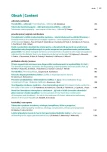Pomalidomide in the treatment of multiple myeloma – own experience and overview of literature
Authors:
Zdeněk Adam 1; Luděk Pour 1; Marta Krejčí 1; Eva Vetešníková 1; Viera Sandecká 1; Martin Štork 1; Zdeňka Čermáková 2,3; Eva Pourová 4; Sabina Ševčíková 5; Zdeněk Král 1; Jiří Mayer 1
Authors‘ workplace:
Interní hematologická a onkologická klinika LF MU a FN Brno, pracoviště Bohunice
1; Oddělení klinické biochemie FN Brno, pracoviště Bohunice
2; Katedra laboratorních metod LF MU, Brno
3; Ordinace praktického lékaře pro dospělé, Pustiměř
4; Ústav patologické fyziologie LF MU, Brno
5
Published in:
Vnitř Lék 2016; 62(12): 962-968
Category:
Original Contributions
Overview
In the Czech Republic, pomalidomide is covered for patients with multiple myeloma (in combination with dexamethasone), in the treatment of patients with relapsed and refractory multiple myeloma, who underwent at least 2 previous treatment schedules including both lenalidomide and bortezomibe, with disease progression despite the last therapy (i.e. during the therapy or within 60 days of its end), for whom the only remaining alternative of treatment (apart from pomalidomide) is that using high-dose dexamethasone, and who are not indicated for myeloablative treatment followed by a transplant of stem cells. At our centre pomalidomide was used in 53 patients at a median age of 66 years based on this indication. Pomalidomide was administered in 1 daily dose over 21 days in 28-day cycles. Considering the risk of thromboembolism occurring in this therapy, all patients were administered a prophylactic dose of low-molecular-weight heparin. No patient achieved complete remission (Czech Republic), 5 patients (9.4 %) achieved very good partial remission (VGPR), partial remission (PR) was achieved by 16 (30.2 %) patients, a minimum therapeutic response (MR) was recorded for 6 (11.3 %) patients. The median number of administered cycles was 4.4 (1–22). 16 (28.5 %) patients received treatment for more than 6 months. The overall survival median cannot be evaluated so far due to a short follow-up period. Nonetheless it was possible to evaluate a median time interval to progression (TTP) for the patients, which amounted to 7.0 (3.8–8.2) months. These results are consistent with large registration studies where therapeutic response (at least PR) is reached by 1/3 of the patients and medians of therapeutic response range between 7–10 months. Pomalidomide is a medicine with very good tolerance which is efficient in patients with a progressing multiple myeloma.
Key words:
lenalidomide – multiple myeloma – pomalidomide – thalidomide
Sources
1. Ščudla V, Bačovský J, Indrák K et al. Results of therapy and changing prognosis of multiple myeloma during the last 40 years in the region of North and Middle Moravia: group of 562 patients. Hematol J 2003; 4(5): 351–357.
2. Ščudla V, Bačovský J, Indrák K et al. Výsledky léčby a změny prognózy u pacientů s mnohočetným myelomem za posledních 40 let ve střední a severní Moravě. Vnitř Lék 2002; 48(8): 707–717.
3. Singhal S, Mehta J, Desican R et al. Antitumor activity of thalidomide in refractory multiple myeloma. N Engl J Med 1999; 341(21): 1565–1571.
4. Weber D, Chen Ch, Niesvitzky R et al. Lenalidomide plus Dexamethasone for Relapsed Multiple Myeloma in North America. N Engl J Med 2007; 357(21): 2133–2142.
5. Dimopoulos M, Spencer A, Attal M et al. Lenalidomide plus Dexamethasone for Relapsed of Refractory Multiple Myeloms. N Engl J Med 2007; 357(21): 2123–2132.
6. Zhu YX, Kortuem KM, Stewart AK. Molecular mechanism of action of immune-modulatory drugs thalidomide, lenalidomide and pomalidomide in multiple myeloma. Leuk Lymphoma 2013; 54(4): 683–687. Dostupné z DOI: <http://dx.doi.org/10.3109/10428194.2012.728597>.
7. McCurdy AR, Lacy MQ. Pomalidomide and its clinical potential for relapsed or refractory multiple myeloma: an update for the hematologist. Ther Adv Hematol 2013; 4(3): 211–216. Dostupné z DOI: <http://dx.doi.org/10.1177/2040620713480155>.
8. Richardson PG, Siegel D, Baz R et al. Phase 1 study of pomalidomide MTD, safety, and efficacy in patients with refractory multiple myeloma who have received lenalidomide and bortezomib. Blood 2013; 121(11): 1961–1967. Dostupné z DOI: <http://dx.doi.org/10.1182/blood-2012–08–450742>.
9. Richardson PG, Siegel DS, Vij R et al. Pomalidomide alone or in combination with low-dose dexamethasone in relapsed and refractory multiple myeloma: a randomized phase 2 study. Blood 2014; 123(12): 1826–1832. Dostupné z DOI: <http://dx.doi.org/10.1182/blood-2013–11–538835>. Erratum in Blood 2014; 123(20): 3208–3209.
10. San Miguel J, Weisel K, Moreau P et al. Pomalidomide plus low-dose dexamethasone versus high-dose dexamethasone alone for patients with relapsed and refractory multiple myeloma (MM-003): a randomised, open-label, phase 3 trial. Lancet Oncol 2013; 14(11): 1055–1066. Dostupné z DOI: <http://dx.doi.org/10.1016/S1470–2045(13)70380–2>.
11. Leleu X, Attal M, Arnulf B et al. Pomalidomide plus low-dose dexamethasone is active and well tolerated in bortezomib and lenalidomide-refractory multiple myeloma: Intergroupe Francophone du Myelome 2009–2002. Blood 2013; 121(11): 1968–1975. Dostupné z DOI: <http://dx.doi.org/10.1182/blood-2012–09–452375>.
12. Dimopoulos MA, Leleu X, Palumbo A et al. Expert panel consensus statement on the optimal use of pomalidomide in relapsed and refractory multiple myeloma. Leukemia 2014; 28(8): 1573–1585. Dostupné z DOI: <http://dx.doi.org/10.1038/leu.2014.60>.
Labels
Diabetology Endocrinology Internal medicineArticle was published in
Internal Medicine

2016 Issue 12
Most read in this issue
- Thrombophilia
- Coffee as hepatoprotective factor
- Oral antidiabetic drugs in treatment of type 1 diabetes mellitus
- Takotsubo cardiomyopathy: incidence, etiology, complications, therapy and prognosis
